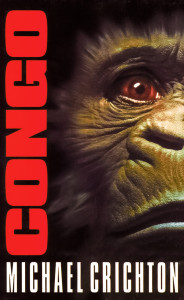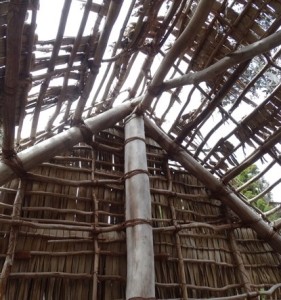 The untouched or virgin rain forest was called primary jungle. Primary jungle was what most people thought of when they thought of rain forests: huge hardwood trees, mahogany and teak and ebony, and underneath a lower layer of ferns and palms, clinging to the ground. Primary jungle was dark and foreboding, but actually easy to move through. However, if the primary jungle was cleared by man and later abandoned, an entirely different secondary growth took over. The dominant plants were softwoods and fast-growing trees, bamboo and thorny tearing vines, which formed a dense and impenetrable barrier.
The untouched or virgin rain forest was called primary jungle. Primary jungle was what most people thought of when they thought of rain forests: huge hardwood trees, mahogany and teak and ebony, and underneath a lower layer of ferns and palms, clinging to the ground. Primary jungle was dark and foreboding, but actually easy to move through. However, if the primary jungle was cleared by man and later abandoned, an entirely different secondary growth took over. The dominant plants were softwoods and fast-growing trees, bamboo and thorny tearing vines, which formed a dense and impenetrable barrier.
That’s Michael Crichton writing in his novel Congo, pointing out that landscapes are as varied and complex as the people who inhabit them.
 I was reminded of this passage during my recent treks through the rain forests of Oahu and Hawaii, where I discovered that jungles that seem impenetrable when seen from a distance can actually be quite easy to walk through, as long as you are willing to let nature be your guide.
I was reminded of this passage during my recent treks through the rain forests of Oahu and Hawaii, where I discovered that jungles that seem impenetrable when seen from a distance can actually be quite easy to walk through, as long as you are willing to let nature be your guide.
Some of the forests that we encountered, particularly those on the less developed Big Island, seemed to be Primary Forests. But all of them–even the ones filled with great tangles of vines and fast growing trees–were cut through with natural paths carved by runoff from the high volcanic mountains that surrounded them.
Naturally, you don’t want to try walking along them when the runoff flows, and the paths that you find might not be going in the direction you want to explore. In that case you might have to assert some dominance by hacking your own trail.
 The people at The Brain Scoop have an interesting video titled “How to Cut a Trail in Amazonia.” It contains a section title “The Trail Team Cuts a Trail,” which offers a concise overview of how one might go about hacking a jungle into submission (and possibly clearing the way for even denser undergrowth in the future).
The people at The Brain Scoop have an interesting video titled “How to Cut a Trail in Amazonia.” It contains a section title “The Trail Team Cuts a Trail,” which offers a concise overview of how one might go about hacking a jungle into submission (and possibly clearing the way for even denser undergrowth in the future).
Click on the image to the left to view the video.
 This post is my fourth in a series of musings about my research trip to the Hawaiian islands. The other posts are My Lost World, Into the Abyss, and Above the Clouds — all of which I was able to finish within a week of returning from my Pacific tour. This post took considerable longer . . . and for a good reason. I mentioned last time that I hoped blogging about the trip would jump start the muse and get me working on the new book. Well, that’s happened.
This post is my fourth in a series of musings about my research trip to the Hawaiian islands. The other posts are My Lost World, Into the Abyss, and Above the Clouds — all of which I was able to finish within a week of returning from my Pacific tour. This post took considerable longer . . . and for a good reason. I mentioned last time that I hoped blogging about the trip would jump start the muse and get me working on the new book. Well, that’s happened.
I have a few other discoveries that I hope to share in the weeks ahead, not the least of which involves the construction of huts entirely out of native plants (right), but the muse is calling: “Scop on!”
Image Credits:
Michael Crichton’s Congo.
*A natural rain forest path.
The Brain Scoop’s How to Cut a Trail Through Amazonia.
*Big Island Hut.
*Photos copyright © 2015 by The 21st-Century Scop.


Leave a Reply